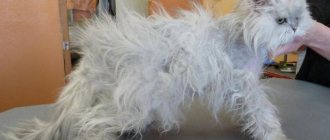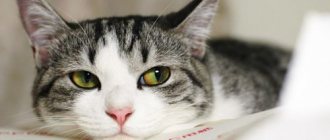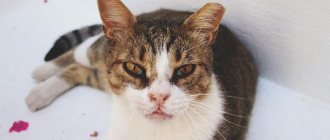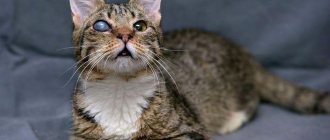You should not have pets thoughtlessly. After all, we are responsible for those we have tamed. If you bring a kitten into your home, get ready for long and painstaking work - after all, you have a long process ahead of you to raise a healthy and smart playful little one. Well, if a cat has health problems, your task is to do everything so that it gets better as soon as possible. Carefully monitor the development of your ward, and if signs of disease occur, one of which may be seemingly harmless dandruff, seek advice from a veterinary hospital.
What is dandruff
The skin of cats consists of several layers, which differ in their morphological structure and functions:
- The connective tissue layer is the deepest layer of the skin. Adipocytes are located here, which act as a fat depot. In addition, connective tissue allows the upper parts of the skin to move relative to the muscles and bones;
- dermis - the middle section of the skin, performs many functions. Its structure consists of papillary and reticular layers. The papillary contains a large amount of collagen, blood vessels and free nerve endings, sebaceous sweat glands, as well as immunocompetent cells involved in the immune response. The reticular layer consists of a denser weave of collagen proteins. Thus, the dermis provides skin trophism, its elasticity and firmness, immune protection from pathogenic factors;
- epidermis - the upper part of the skin, which performs a protective function. The structure of this section consists of several components - dead epithelial cells are located on top, keratinized cells lie below, after which living ones are found. On average, the skin thickness of cats is about 10-20 microns.
Thus, the appearance of a small amount of dandruff is a normal physiological process, as it signals the renewal of epidermal cells that perform a protective function. The largest number of detached scales can be found in the area of the pet's back and tail, as well as behind the ears.
The appearance of a large number of flakes over the entire area of the fur or, conversely, with a clear localization, the addition of other symptoms most likely reflects a pathological process.
Signs
The main signs of dandruff that require a diagnostic search include:
- the presence of large and small white scales on the fur, localized throughout the pet’s fur;
- the scales are located in a clearly demarcated area;
- multiple scratches and wounds with dried blood in the form of crusts are found on the skin;
- changes in skin color, presence of rashes and other changes;
- the cat diligently licks the affected area;
- dulling of the coat, the formation of lumps and tangles, increased hair loss.
Kinds
In the case of increased death of epithelial skin cells in a cat, the presence of seborrhea is said to be present. Depending on the causes of the pathology, the symptom will manifest itself differently, so oily and dry seborrhea are distinguished.
- Oily seborrhea is characterized by the appearance of epithelial scales mainly behind the ears, on the back and in the tail. In areas where dandruff is present, the coat is characterized by increased fat content and an unkempt appearance. The scales are difficult to separate from the hair. Upon examination, you can detect an accumulation of dead epithelium under the fur.
- Dry seborrhea is manifested by the appearance of small scales of dead epithelium, which spread evenly over the entire surface of the coat. In this case, the hairline loses its shine as a result of decreased function of the sebaceous glands, and the scales of epithelial cells are easily separated from the hair. On examination, dry skin is observed. Most often, pathologies are accompanied by a combined type of dandruff, which includes manifestations of both dry and oily seborrhea.
Signs of trichophytosis
Perhaps the most severe type of mycosis of the scalp is in the hair growth area, as a result of which the patient loses hair. Differentiate between superficial and deep forms.
With superficial trichophytosis, you can first detect flaky lesions and brittle hair at the base of the follicles, as a result of which the scalp is covered with black dots. On the remainder of the hair after breaking, you can notice a gray coating. The affected areas may become red, itchy, and swollen.
The deep form manifests itself as general malaise, hyperthermia; an infected person may notice swelling and tenderness of the lymph nodes, and a rash. Pink-red spots can be found on the scalp, rising above the surface of the epidermis. They have clear contours and a round shape. The most abundant peeling is observed along the contour of the spot. Less commonly, vesicles (bubbles with liquid) can form along the contour. Such lesions spread quite quickly, which is highly likely to lead to an abscess.
Causes of dandruff in cats and kittens
There are a large number of pathologies that are accompanied by the appearance of dandruff in cats. This symptom is observed in almost all dermatological ailments, in case of endocrine system disorders, in infectious diseases and other somatic diseases.
- Fungal skin infections are a common cause of dandruff in animals. The most common disease is ringworm or microsporia. The causative agent is the fungus Microsporum. The pathological process in most cases affects the skin. At the same time, lesions devoid of fur can be found on the pet’s body, and in the affected area there is an accumulation of a large number of dead epithelial cells. As a rule, the fungus damages the epidermis in the area of the ears, tail, head and limbs. The disease is contagious and often infects a person if hygiene is not observed. Long-term use of antibiotics or a weakened immune response can lead to the development of candidiasis. The disease manifests itself as skin lesions in the form of ulcers, and dandruff appears near the site of damage. In addition, the fungus damages the mucous membranes of the oral cavity. Another fungal disease is Malassezia. The pathology is localized in the area of the ears, as well as in some internal organs.
- Bacterial infections rarely affect the skin. Most often, secondary pathogenic flora attaches to wounds and injuries. One of the nonspecific signs of damage is the formation of dandruff. The main symptoms of bacterial skin lesions may be the formation of ulcers, local hair loss, itching, restless behavior of the animal, and increased body temperature.
- Demodicosis is a disease that develops as a result of an ixodid tick bite. Signs of skin irritation, severe itching and profuse dandruff appear.
- An allergic reaction is an inadequate response of the immune system, mediated by immunoglobulins of various classes, in response to any antigen entering the body. Sensitization of a cat’s body can be either congenital or acquired. Most often, allergies develop to food, flea saliva and some environmental factors.
- Hypothyroidism is a decrease in thyroid function. Thyroid hormones carry out protein metabolism and maintain high activity of metabolic processes. When the secretion of hormones decreases, a cat experiences decreased activity, increased hair loss, lethargy, and in severe cases, a decrease in body temperature and a decrease in heart rate are possible. The pathology rarely develops in cats. As a rule, the development of hypothyroidism occurs against the background of organ removal or as a result of radiotherapy for hyperthyroidism, a disease accompanied by increased secretion of thyroid hormones by the thyroid gland.
- Cushing's syndrome is a pathology associated with an increase in the production of steroid hormones by the adrenal glands, or their regular introduction into the body in the treatment of various diseases. The pathogenesis of the disease is a violation of carbohydrate, fat and protein metabolism. The clinical picture is represented by general signs of malaise of the animal, increased thirst, decreased activity and muscle atrophy, increased abdominal volume, thinning of the epidermis and an increased rate of death of epithelial cells.
- Nutritional reasons are most often associated with insufficient intake of vitamins E, K and others into the pet’s body. In this case, peeling of the skin goes away as a result of adjusting the diet.
- Lymphoma is a malignant disease characterized by the formation of atypical cells from lymphoid tissue. The etiological factor has not been studied, but a viral cause of the pathology is suspected. The clinical picture depends on the stage and localization of the pathology. The extranodular form can be located on the skin, resulting in the formation of ulcers, eczema and peeling of the epidermis.
- Obesity leads to various complications. The coat loses its healthy shine, oily seborrhea appears as a result of increased function of the sebaceous glands. In addition, the functioning of the endocrine and cardiovascular systems is disrupted. Therefore, excess weight in a cat is a reason to reconsider the diet and consult a specialist to identify the causes of the development of pathology.
- The action of external factors can adversely affect the condition of the skin. Excessive overheating or exposure to the sun leads to dryness of the epidermis, which leads to an increase in the rate of death of epithelial cells.
- Digestive diseases lead to a decrease in skin quality, which can manifest itself in the form of dandruff. Read about gastritis in cats and kittens.
Treatment
In order for the treatment of dandruff in a cat to be successful, it is necessary to establish the cause of the disease. Only a veterinarian can do this fully. The doctor will examine the animal and, if necessary, prescribe a diagnostic examination, which may include the following medical tests:
- general blood analysis;
- blood chemistry;
- skin scraping;
- skin biopsy.
A timely visit to a specialist will help you avoid problems such as cat baldness in the future. After all, dandruff disrupts the supply of oxygen to the hair follicles, as a result of which the hair begins to actively fall out.
If a medical examination does not reveal serious diseases of the cat’s internal organs, then the veterinarian may recommend the following methods to treat dandruff:
- use of dermatological shampoos and sprays;
- dietary nutrition;
- taking vitamin complexes.
Anti-dandruff shampoos and sprays
Dermatological shampoos and sprays will help you get rid of seborrhea in your cat. The most effective means include:
- Shampoo Globalvet. The shampoo contains zinc perithione, which has a detrimental effect on pathogenic bacteria and fungi; salicylic acid, which normalizes the functioning of the sebaceous glands. The cosmetic product not only effectively eliminates dandruff, but also reduces skin itching, relieves irritation, and has a moisturizing effect. The method of application is very simple: the shampoo is applied to the animal’s fur in the required amount, massage movements are carried out for 2-3 minutes, then the product is washed off with water. The shampoo can be used daily. The average cost is 380–420 rubles for a volume of 150 ml.
Globalvet shampoo is an effective remedy for dandruff in cats
- Beaphar Anti Dandruff Shampoo. Contains natural oils of calendula, bergamot and lavender, as well as salicylic acid. The product has an anti-inflammatory and antimicrobial effect, eliminates seborrhea, and moisturizes the skin. The application regimen is similar to the method of using Globalvet shampoo. Cost - 990 rubles for a volume of 250 ml.
- Tropiclean Oxy-Med Anti-Itch Spray. Contains salicylic acid, vitamins A and E, omega-3 and omega-6 fatty acids. The spray eliminates dandruff, accelerates the regeneration of the epidermis, and quickly relieves skin itching of various origins. The product is applied to the affected areas of the skin and does not require rinsing. Cost - 600 rubles for a volume of 236 ml.
Diet food
Diet is an important element in treating any type of dandruff in a cat. To speed up the healing process, it is recommended to switch the animal to feeding natural products. So, you should actively include the following components in your diet:
- beef liver, rich in vitamins A and B;
- fish oil, including omega-3, vitamin A, antioxidants;
- vegetables: zucchini, pumpkin, broccoli, carrots.
According to veterinary nutritionists, a cat's diet should include at least 20% vegetables.
If your pet refuses to eat natural food, you should be more careful when choosing food. When using economy-class food in a cat's diet, it should be replaced with a more expensive and high-quality one. However, it should be remembered that the transition to another food should be gradual. Otherwise, you may get a side effect in the form of disruption of the gastrointestinal tract.
Vitamin complexes
Vitamin complexes will help normalize the condition of your pet’s skin, and therefore get rid of dandruff. You can opt for the following pharmaceutical products:
- vitamin and mineral complex "Radostin", which includes vitamins A, B1, B2, B6, B12, C, E; phosphorus, iron, calcium. The product is used daily. The course of treatment is 14–30 days. Product cost - 195 rubles;
The vitamin and mineral complex "Radostin" will help compensate for the lack of nutrients in a cat's body.
- vitamin and mineral complex "Polidex Multivitum", containing vitamins A, B1, B5, B12, E; calcium, iron, manganese. Dosage regimen: 1–3 times a day for 2–3 months. Next, a break is taken for 1–2 months. The vitamin-mineral complex can be used both for vitamin deficiency in cats and for preventive purposes. The price of the product is 500 rubles.
Vitamin and mineral complexes will not only help get rid of dandruff in a cat, but will also increase immunity and strengthen the musculoskeletal system.
Treatment of seborrhea in a kitten
The appearance of dandruff does not depend on the age of the pet, so it can also appear in kittens. Treatment of dandruff in babies is the same as in adult cats.
Diagnostics
If a large number of dead epidermal scales appear on your pet’s fur, as well as other symptoms, you should contact your veterinarian. The specialist will collect anamnestic data, with increased attention paid to the cat’s nutrition, cosmetics used, and the characteristics of the pet’s habitual behavior.
A physical and external examination of the animal may reveal any abnormalities in the skin, fur, musculoskeletal system and other organ systems.
Further diagnostic search is based on the use of additional research methods. The doctor will prescribe a blood and hormone test, a cytological examination of the epidermis, in some cases a biopsy and other types of examination are required.
Prevention measures
The appearance of dandruff on your cat's fur can be prevented. To do this you will need:
- Brush your pet periodically, especially if it has long hair, and also during shedding;
- prevent the animal from staying in the sun for a long time;
- provide a balanced diet, sufficient amounts of vitamins and minerals;
- when feeding industrial formulations, carefully read the information about the ingredients they contain, avoiding large amounts of allergenic substances (dyes, preservatives, flavors);
- during water procedures, monitor the water temperature, preventing it from increasing;
- buy quality shampoos;
- regularly carry out prevention of internal and external parasites;
- monitor the caloric content of your cat’s food, avoiding excess weight;
- eliminate stress.
When you notice the first symptoms, you must take your cat to a veterinarian. You should not treat dandruff on your own through trial and error.
Medicines
If your pet develops a fungal disease, it is recommended to use special shampoos. One of the most effective is Synergy Labs Veterinary Formula. The product has anti-inflammatory, bactericidal and antifungal effects. The composition of the shampoo is hypoallergenic, so it will not cause an unpredictable reaction in your pet.
The main therapy for the disease is prescribed by a doctor after making a diagnosis and conducting all the necessary research methods. Fungal skin diseases are treated with Amphotericin, Clotrimazole and other drugs. Medicines in the form of ointments are effectively absorbed and lubricate the affected areas of the skin. You can also use tablet forms. Also read the article on how to give a cat a pill.
Cushing's syndrome, caused by a malfunction of the adrenal glands, requires medication, most often Trilostane. If conservative treatment is ineffective, surgical removal of the adrenal glands or pituitary gland is prescribed.
Therapy for hypothyroidism involves replacement therapy with thyroid hormones, as well as dietary adjustments with an increase in foods containing iodine in the menu.
External reasons
External factors include:
- fungus. Due to the activity of fungal microorganisms, excessive exfoliation of the skin occurs;
- burned by the sun's rays. When exposed to the sun, the skin is affected by UV rays, as a result of which the top layer of the skin dries out and dandruff appears;
- poor hygiene. You need to properly care for your cat, but without fanaticism. With insufficient care and excessively frequent bathing with detergents, dandruff may appear;
- parasites. Fleas and ticks infect the skin, disrupt the activity of the sebaceous glands, resulting in excessive exfoliation of the skin;
- ecology. Unsuitable humidity and temperature conditions negatively affect the skin. Dryness and heat lead to flaking, which results in dandruff.
Complications
Increased desquamation of the epithelium leads to a deterioration in the condition of the coat. In the case of dry seborrhea, the hair becomes dull and brittle, and in the oily form, it becomes untidy and greasy. In addition, the underlying disease can lead to undesirable consequences. Thus, a fungal infection of the skin over a long period of time and without treatment is complicated by a bacterial infection. Endocrine diseases adversely affect the general condition of the pet, and also contribute to the formation of chronic diseases of the internal organs.
How does scalp fungus manifest itself: the most common symptoms
The cause of itching, flaking (dandruff), and hair loss is very often a fungus (mycosis). The most common areas of the scalp are:
- Microsporum: cause microsporia;
- Trichophyton: are the causative agents of trichophytosis (ringworm);
- Malassezia furfur: leads to seborrhea.
Each infection will manifest itself differently, but some of the most common alarming symptoms can be identified - the simultaneous manifestation of two or more should alert every person:
- sudden deterioration in the general condition of the hair: it became dry, dull, and began to fall out profusely;
- dandruff has appeared (even though this has not been observed before), and/or its amount is increasing;
- separately localized flaky areas appeared;
- bald spots and bald spots form, which quickly grow;
- wounds, crusts, and bumps of unknown origin were found on the scalp;
- the hair becomes brittle at the base of the follicle, resulting in black spots appearing on the skin.
Mycoses do not reveal themselves at an early stage, so you should be very careful and if any symptom appears, immediately contact a specialist. Trichologists or dermatologists deal with problems of the scalp.











